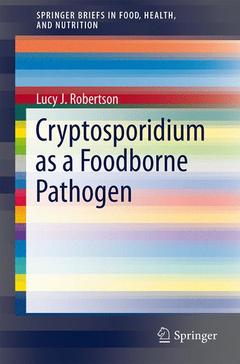Cryptosporidium as a Foodborne Pathogen, 2014 SpringerBriefs in Food, Health, and Nutrition Series
Auteur : Robertson Lucy J.

Introduction to Cryptosporidium – the parasite and the disease.- Transmission routes and factors that lend themselves to foodborne transmission.- Documented foodborne outbreaks of cryptosporidiosis.- Approaches to detecting Cryptosporidium oocysts in different food matrices.- Occurrence of Cryptosporidium oocysts in different food matrices: results of surveys.- Inactivation or decontamination procedures.- Risk assessment and regulations.- Future challenges.- Conclusions.- References.
Includes supplementary material: sn.pub/extras
Date de parution : 11-2013
Ouvrage de 90 p.
15.5x23.5 cm
Disponible chez l'éditeur (délai d'approvisionnement : 15 jours).
Prix indicatif 52,74 €
Ajouter au panier


